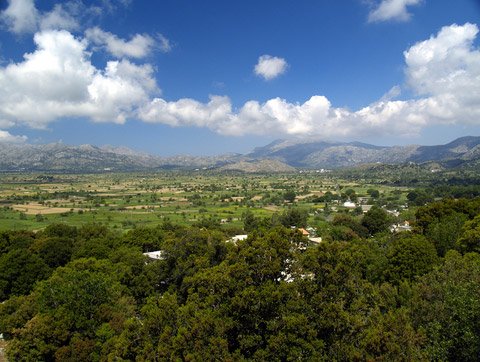A Minoan civilization was unheard of when archaeologists began their work on Crete in the late 19th Century.
They expected to find the usual classical Greek or Roman remains, but to their surprise they discovered a much older civilization. Arthur Evans was the person responsible for the name and much of the theory of this ancient people, although some of his ideas have been revised if not rejected outright.
Arthur Evans was given permission to dig at a place called Knossos, and he couldn’t believe his luck. He turned up discovery after discovery, rooms, thrones, artifacts and frescoes. He named the people who had lived there the ‘Minoans’, after the name of the legendary king Minos. Minos was supposed to have ruled during the time of the Minotaur, a fearsome half-man, half-bull creature, who lived in a labyrinth. The Athenian hero Theseus killed the Minotaur and rescued Ariadne.

Development of the palaces
As archaeologists studied the ancient Minoan civilization, they detected two distinct periods of activity. They called these the Old Palace period and the New Palace Period.
Old Palaces
This period occurred from 2000 BC to about 1700 BC. It saw the development of very large palace structures. In the centre of these was a courtyard, surrounded by smaller houses, shops and workshops.
Excavations reveal that these palaces were destroyed in about 1700 BC.
New Palaces
After 1700 BC the palaces were rebuilt on the same sites. Only this time they were far more elaborate. The furnishings used in the living quarters were rich and luxurious, and the walls of these rooms were highly decorated with colourful frescoes.
The structure of their society
If you’re going to have any sort of society, you have to have some sort of structure. The Minoan civilization was highly orgainised. It was run by priests, who maintained their power by controlling essential commodities, such as food, drink and olive oil.
In many storerooms of the palaces you can see large pithoi. Associated with these were seal stones which indicated ownership, and clay tablets for keeping account of who owed what to who.

Features of the Minoan civilization
It is clear from statues and frescoes that women played a major part in the Minoan civilization. Many of the finds from the palaces are of clay figurines of the female Snake goddess.
Another unique feature was the practice of ‘bull leaping’. The frescoes show young men apparently leaping over charging bulls. There are constant debates as to whether this is physically possible.
End of an era
The New Palace period came to an end in about 1450 BC. There is ample evidence that fire was a major contributor. Whether the fires were started deliberately, or were the result of a natural catastrophe is not known. There are various theories as to what happened. Some think the Minoans were simply overrun by the rising power of Mycenae. Others suggest the eruption on Santorini was to blame, and wiped out the palaces. But it is thought the Santorini eruption occurred about 1500 BC, which was too early.
A more recent variation on this is that the eruption on Santorini devastated the Minoan civilization by the resulting tsunami wiping out the shipping fleets of the Minoans. Their society was fatally weakened by this, and the Mycenaeans were easily able to conquer the island.
Whatever the initial cause of the decline of the palace society, from 1450 BC to 1100 BC the Mycenaeans ruled ancient Crete. They used Knossos as an administrative centre until about 1200 BC, when they abandoned it.

Undeciphered scripts
Although the Minoan civilization had now come to an end, it left its mark on the inhabitants of Crete. Right up to the 3rd C BC the native Cretans kept their language and customs which they had inherited from the past. Even Homer refers to them in his Odyssey, and mentions how the true natives of Crete were proud of their past.
These native Cretans have left behind some fascinating inscriptions. They remain fascinating because so far no one has been able to decipher them. These inscriptions have been found at Dreros and Praisos. A famous relic is the “Phaestos Disk”, a round clay disk which also remains a mystery but may be in the process of interpretation.
A new resource for all things Minoan: Minoan News
Recent Discoveries for ancient Greece
Main places of interest
No one who visits Crete should miss the main attraction of the Minoan civilization, which is the site at Knossos. Situated just to the south of Heraklion, the capital of Crete, Knossos is the most important of all the Minoan sites. Phaestos and Malia are lesser known but also well worth a visit. There are numerous small sites if you have a special interest in this ancient civilization.
Recent discoveries have been made at the active archeology site of Kommos near the resort town of Matala, including ancient boat sheds that had not been previously identified. More information, photos and diagrams at the University of Toronto Kommos site
In the spring of 2014 the Minoan Collection at the Heraklion Archaeological Museum re-opened after extensive remodeling. It is a “must see” as well. More on the Heraklion page